The Himalayan Cuckoo represents a remarkable example of nature’s intricacy and adaptability. Its existence in the high-altitude realms of broadleaved forests, its insectivorous diet, and extensive migration from Asia to Africa underscores its resilience in the face of challenging conditions.
While mysteries surrounding its behavior and survival strategies persist, its current “Least Concern” conservation status underscores the importance of preserving its habitat and biodiversity.
By promoting sustainable practices and fostering a deeper understanding of our interconnectedness with all living beings, we can ensure the continued well-being of the Himalayan Cuckoo and contribute to the conservation of our planet’s diverse ecosystems.
Let us remain committed to exploring, protecting, and cherishing the wonders of nature for generations to come.
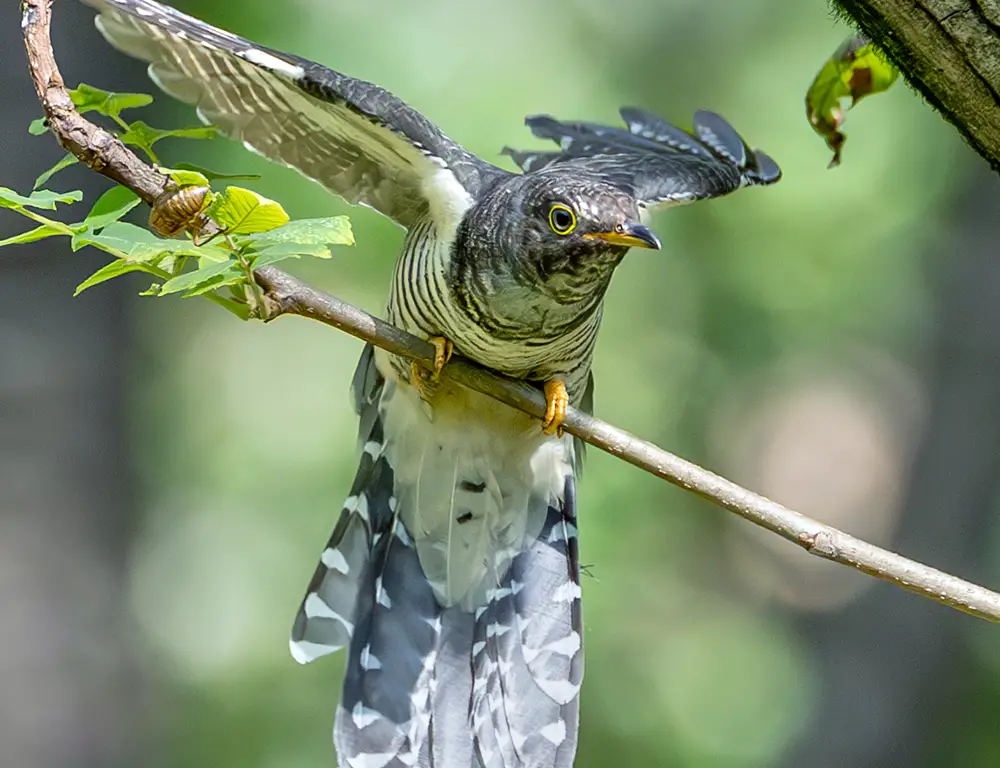
Physical Characteristics of Himalayan Cuckoo
The physical characteristics of the Himalayan Cuckoo (Cuculus saturatus) are distinct and adapted to its high-altitude habitat in the Himalayan region.
Here’s an overview of its fundamental physical traits:
Size
The Himalayan Cuckoo is a moderately sized bird, typically measuring around 30 to 35 centimeters (12 to 14 inches) in length.
Plumage
Its plumage is predominantly greyish-brown on the upperparts, providing effective camouflage against the rocky terrain of the Himalayas. The underparts are lighter, often featuring delicate cross-stripes.
The breast area may have white and black barring, adding to its intricate patterning.
Tail
The Himalayan Cuckoo’s tail is long and broad, with distinctive white tips on the feathers. This tail structure aids in flight stability and maneuverability, particularly in mountainous environments.
Bill
It has a downward-curved bill, well-suited for capturing its preferred prey, such as caterpillars. The bill is typically dark, with variations in coloration at the base, ranging from orange-yellow to green-yellow.
Legs and Feet
The legs and feet of the Himalayan Cuckoo range in color from yellow to orange, providing a striking contrast against the muted tones of its plumage.
Eye-ring
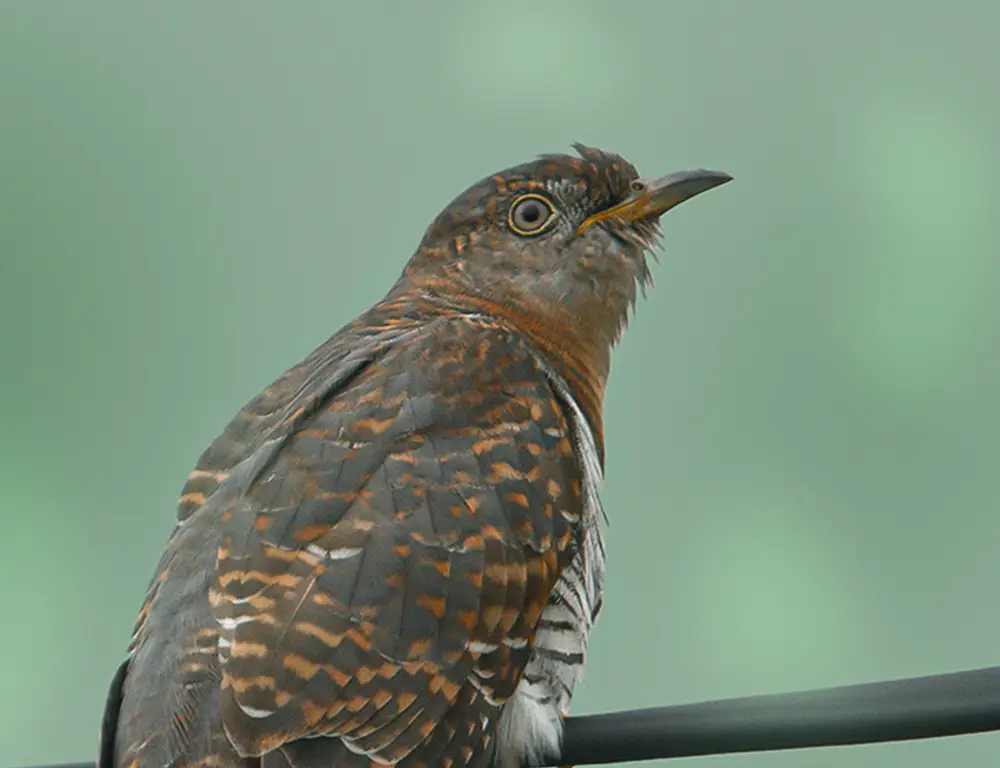
It features a prominent yellow eye-ring encircling its dark-colored eyes, adding to its overall appearance.
Wings
The wings of the Himalayan Cuckoo are notable for their broadness and the spacing of their black bars. These wing features facilitate efficient flight and maneuverability, essential for navigating its mountainous habitat and undertaking long migratory journeys.
Habitat and Distribution of Himalayan Cuckoo
The Himalayan Cuckoo (Cuculus saturatus) is primarily found in the high-altitude regions of the Himalayas, where it inhabits diverse habitats and undertakes extensive migrations. Here’s an overview of its habitat and distribution:
Habitat
The Himalayan Cuckoo (Cuculus saturatus) inhabits various habitats across its range, primarily in the high-altitude regions of the Himalayas.
Here’s a closer look at the habitats favored by the Himalayan Cuckoo:
Mountainous Regions
The Himalayan Cuckoo is well-adapted to mountainous environments, where it can be found in various habitats ranging from dense forests to shrublands and montane grasslands. These habitats provide the bird with ample food resources and suitable nesting sites.
Broadleaved Forests
It often occurs in broadleaved forests, where it can forage for insects and seek shelter in the dense vegetation. These forests provide diverse food sources and support a rich ecosystem of plants and animals.
Mixed Coniferous and Deciduous Forests
The Himalayan Cuckoo also inhabits mixed coniferous and deciduous forests, where it can find a mix of tree species and associated wildlife. These forests offer a variety of food and nesting opportunities throughout the year.
Shrublands and Montane Grasslands
In addition to forests, the Himalayan Cuckoo can be found in shrublands and montane grasslands, especially in areas where forests are sparse or fragmented. These open habitats provide suitable foraging grounds and may serve as stopover sites during migration.
Distribution
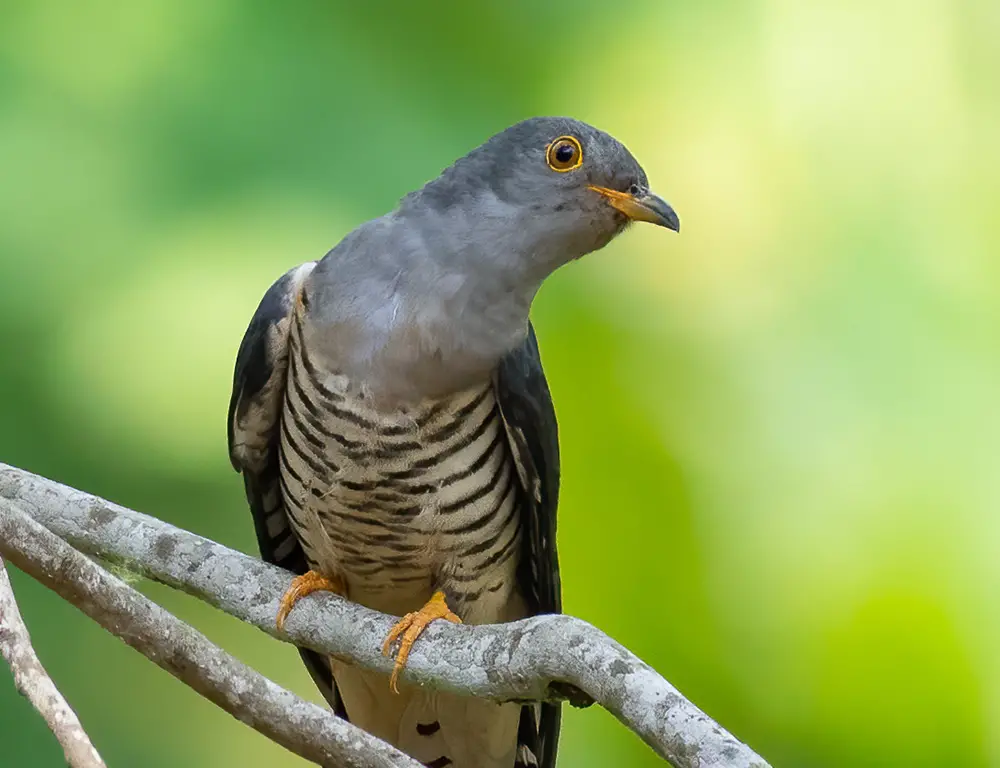
The Himalayan Cuckoo (Cuculus saturatus) is primarily distributed across the high-altitude regions of the Himalayas and adjacent areas.
Here’s a breakdown of its distribution:
Breeding Range
The primary breeding range of the Himalayan Cuckoo spans the Himalayan region, including countries such as Nepal, Bhutan, India, Pakistan, and parts of China.
This range is distributed across a wide altitudinal gradient, from lower foothills to higher mountain slopes.
Migration Routes
During the non-breeding season, Himalayan Cuckoos undertake extensive migrations to wintering grounds in Southeast Asia and the Greater Sunda Islands.
Their migration routes typically take them southward through Myanmar, Thailand, Laos, Cambodia, and Vietnam.
Wintering Grounds
In winter, Himalayan Cuckoos can be found in various habitats in their wintering grounds, including tropical forests, wetlands, and agricultural areas.
They may also occur in urban and suburban environments, especially in areas with suitable food sources and shelter.
Behavior and Diet of Himalayan Cuckoo
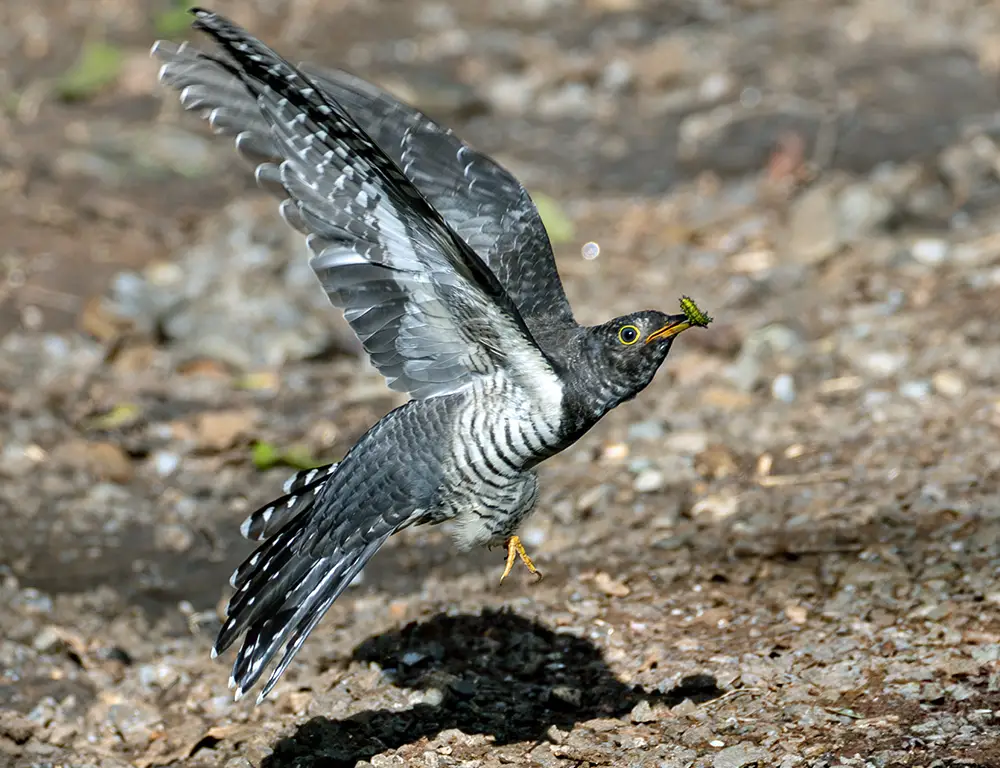
The behavior and diet of the Himalayan Cuckoo (Cuculus saturatus) are shaped by its high-altitude habitat in the Himalayas and its migratory lifestyle.
Here’s an exploration of its behavior and dietary preferences:
Behavior
The behavior of the Himalayan Cuckoo (Cuculus saturatus) encompasses various aspects of its life, including nesting, vocalizations, migration, and foraging.
Here’s a closer look at some key behaviors of this fascinating bird:
Nesting Behavior
Himalayan Cuckoos exhibit intriguing nesting behavior. While some individuals engage in brood parasitism, laying their eggs in the nests of other bird species, many are believed to construct their nests.
When engaging in brood parasitism, they often target nests of small perching birds, such as drongos or bulbuls, laying their eggs to be incubated and raised by the unsuspecting host.
Vocalizations
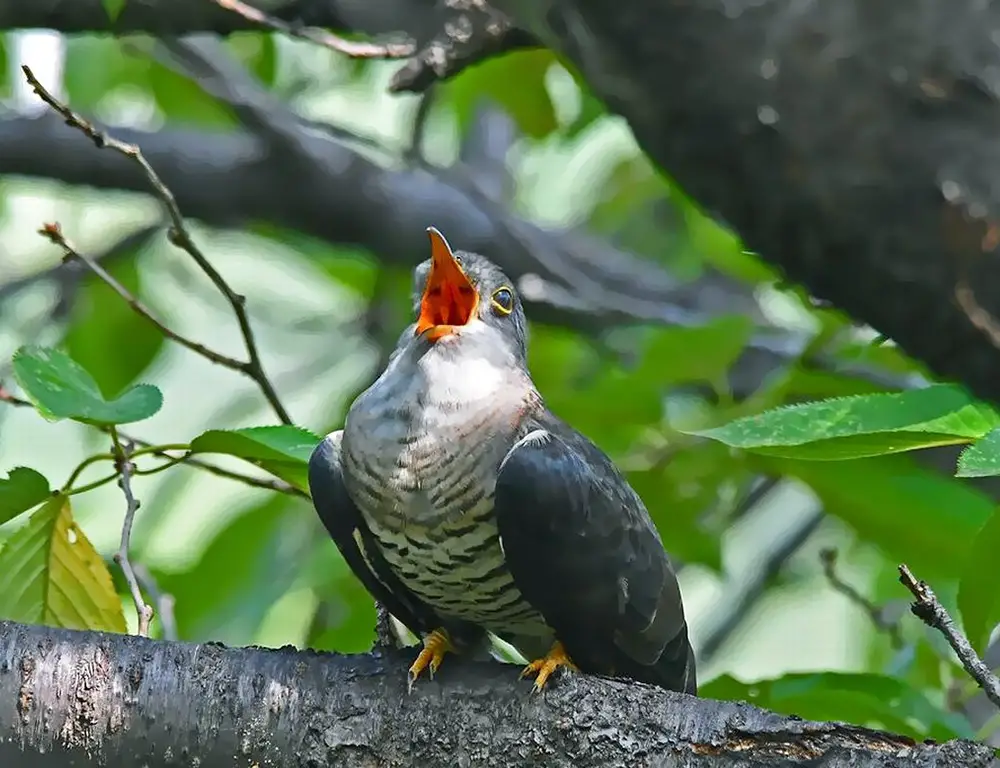
The calls of the Himalayan Cuckoo are distinctive and melodious, consisting of four notes repeated over time, often described as ‘coo-coo-cu-coo.’
These calls serve various purposes, including communication between individuals, establishing territory, and courtship displays.
Additionally, Himalayan Cuckoos are skilled mimics, capable of imitating the songs of other bird species with remarkable precision.
Migration
Himalayan Cuckoos are renowned for their extensive migratory journeys. They travel thousands of miles annually, migrating from their breeding grounds in the Himalayas to wintering grounds in Southeast Asia and the Greater Sunda Islands.
Migration typically occurs from June/July to October/November, with birds returning home by March/April the following year. These migrations are guided by factors such as food availability and seasonal changes.
Foraging Behavior
Himalayan Cuckoos are primarily insectivorous, with caterpillars being a favored delicacy. They forage for food by perching in trees and shrubs, scanning their surroundings for prey items.
They may also join mixed-species feeding flocks during non-breeding seasons, where they can benefit from increased foraging efficiency and safety in numbers.
Diet
The diet of the Himalayan Cuckoo (Cuculus saturatus) primarily consists of insects, supplemented occasionally with fruits and small animals.
Here’s a closer look at its dietary preferences:
Insects
Most of the Himalayan Cuckoo’s diet consists of insects, with caterpillars being a favored food source. They feed on insects, including beetles, ants, flies, and other small invertebrates.
Their insect-rich diet gives them essential nutrients and energy for their demanding lifestyle.
Fruits
While insects form the bulk of their diet, Himalayan Cuckoos may also consume fruits, mainly when they are in season and readily available. Berries and other fleshy fruits may supplement their diet, providing additional nutrients and moisture.
Small Animals
Occasionally, Himalayan Cuckoos may feed on small animals such as lizards or frogs if they encounter them within their habitat. However, these items are less common in their diet compared to insects and fruits.
Conservation Status of Himalayan Cuckoo
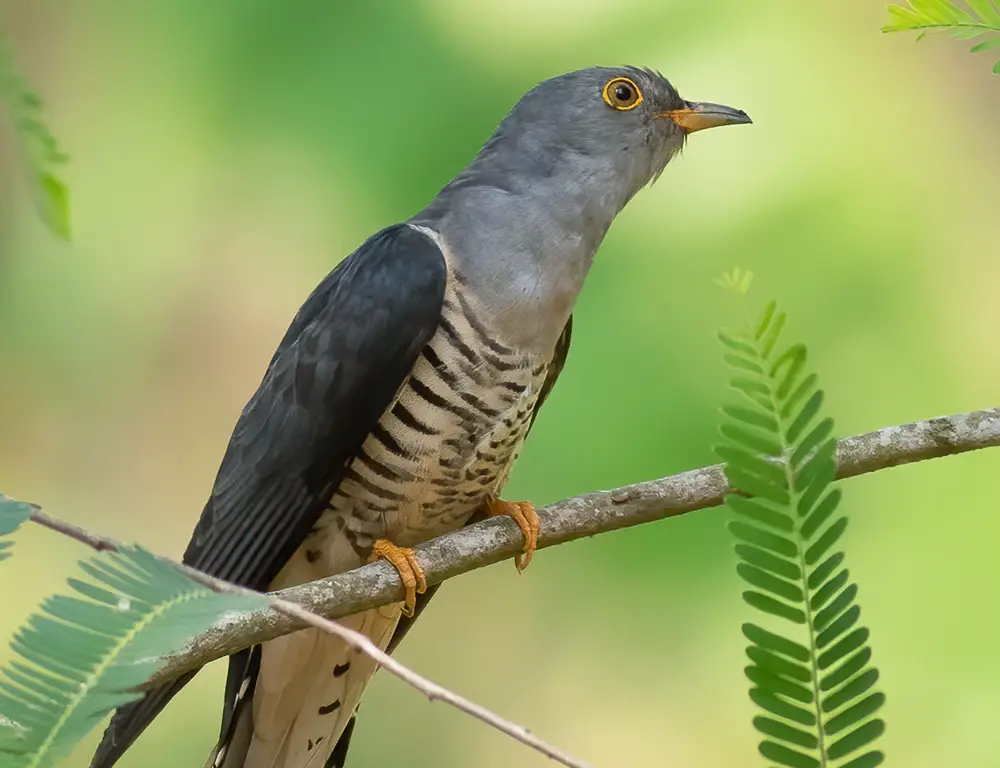
The Himalayan Cuckoo (Cuculus saturatus) holds a conservation status of “Least Concern,” as assessed by the International Union for Conservation of Nature (IUCN). This classification indicates that the species is not currently facing imminent threats to its survival.
Let’s delve into the factors contributing to this status:
Population Size
While precise population estimates are challenging due to the species’ elusive nature and remote habitat, observations suggest that the Himalayan Cuckoo maintains a stable population.
Trend in Population
No significant trends indicate a severe decline or rapid increase in Himalayan Cuckoo populations. Monitoring efforts, where feasible, have not shown any alarming population declines.
Breeding Success
Observations suggest that Himalayan Cuckoos exhibit normal breeding behavior, including nesting and successful reproduction.
While some individuals engage in brood parasitism, many are believed to build their nests, contributing to stable breeding populations.
Known Threats
No significant threats that threaten the Himalayan Cuckoo’s survival have been identified.
However, like many bird species, they may face localized threats such as habitat loss, fragmentation, and degradation due to human activities, including deforestation, agriculture, and infrastructure development.
Geographical Range
The Himalayan Cuckoo occupies a broad geographical range across the Himalayan region, extending from Afghanistan through India and China to Russia.
This wide distribution provides resilience against localized threats and ensures the species’ presence in diverse habitats.
FAQs
How does the Himalayan Cuckoo contribute to its ecosystem?
The Himalayan Cuckoo plays a vital role in its ecosystem by controlling insect populations, aiding in seed dispersal through its feeding habits, and serving as prey for predators, thus contributing to the overall balance of the ecosystem.
What are the main predators of the Himalayan Cuckoo?
Common predators of the Himalayan Cuckoo include birds of prey such as hawks and eagles and larger mammals like mongooses and snakes.
What are the social behaviors of the Himalayan Cuckoo?
While primarily solitary, Himalayan Cuckoos may exhibit social behaviors such as territorial displays and interactions during breeding seasons or foraging in mixed-species flocks.
How do environmental changes impact the Himalayan Cuckoo?
Environmental changes, such as habitat loss, climate change, and pollution, can affect the Himalayan Cuckoo by altering its habitat, food sources, and migration patterns, potentially leading to population declines and endangerment.
Are there any cultural or symbolic significance associated with the Himalayan Cuckoo?
In some cultures, the Himalayan Cuckoo may hold symbolic significance, representing traits such as resilience, adaptability, or the beauty of nature. Additionally, its migratory journey may inspire awe and admiration among people who witness it.
Conclusion
With its habitat in high-altitude broadleaved forests, the Himalayan Cuckoo showcases nature’s resilience and interconnectedness. Its insectivorous diet and epic migratory journey from Asia to Africa highlight its adaptability and endurance.
While much remains to be discovered about its behavior and survival strategies, its current “Least Concern” conservation status reminds us of our duty to protect all species and their habitats.
By embracing sustainable practices and fostering biodiversity, we safeguard the Himalayan Cuckoo and preserve the intricate balance of our planet’s ecosystems.
Let us continue to explore and appreciate the wonders of nature, ensuring a harmonious coexistence with all living beings.